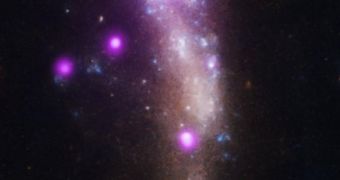Astronomers were recently able to capture the first image ever of a supernova shock wave making its way through the gaseous cocoon that surrounded the exploded star. This was made possible through the use of the NASA Chandra X-ray Observatory.
Using the amazing capabilities of the CXO, a team of experts managed to photograph a phenomenon whose analysis might reveal the real reasons behind why some supernova blasts are many times more powerful than other. The difference exists even between progenitor stars that are nearly identical.
The supernova Chandra observed is called UGC 5189A and was first identified on November 3, 2010. Located some 160 million light-years away, the object is believed to have exploded in early October, 2010, though no observatories picked the event up at that time.
Before the progenitor star exploded, it releases some of its atmosphere in its surroundings. The material formed a cocoon of gas. When the star exploded, the shock waves of the tremendous blast pierced through this gas shell. The phenomenon was never before imaged in such detail.

 14 DAY TRIAL //
14 DAY TRIAL //